Beautyberry (Callicarpa americana) Profile
Written by Iris
Nov 13 2021
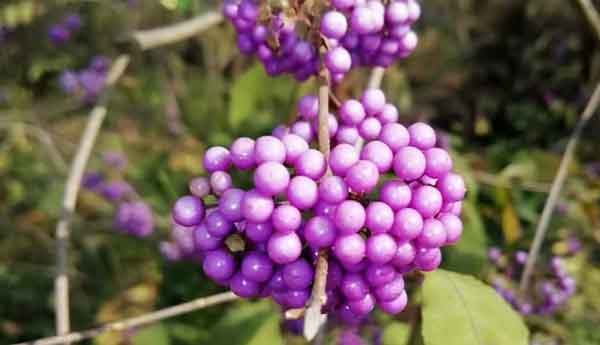
Beautyberry (Callicarpa americana) grows in thick woods and brush in east Texas, especially in coastal plain pine forests. Beautyberry (Callicarpa americana) begins the summer with small, inconspicuous greenish-white flowers, but is followed by clusters of beautiful purple berries clinging to the branches in late summer. Beautyberry (Callicarpa americana) works best in semi-shade with a certain amount of moisture. If it is watered, Beautyberry (Callicarpa americana) can tolerate plenty of sunlight and can tolerate some drought.
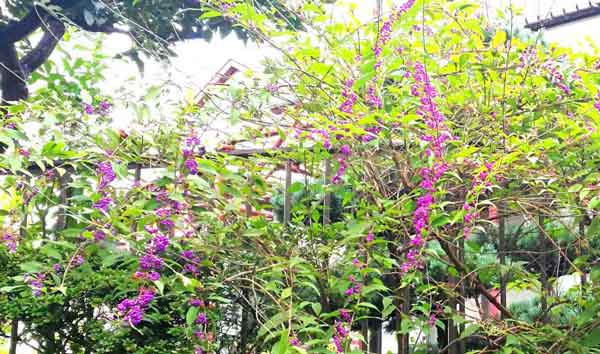
Beautyberry's native habitat is open meadows, thickets, or woodlands. In the spring, green leaves emerge on upright arching stems. Clusters of small flowers bloom on the stems during the late spring and early summer. Clusters of purplish to bluish berries develop August through October and encircle the stem.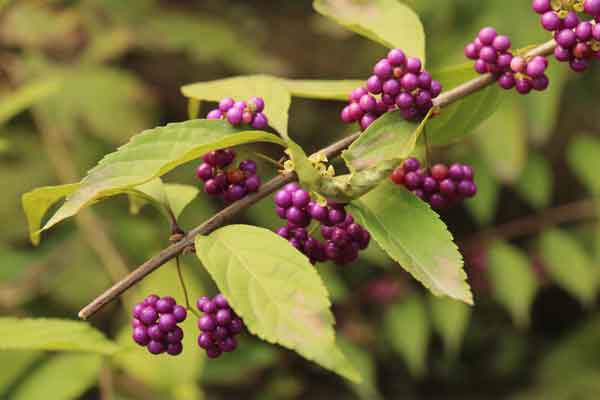
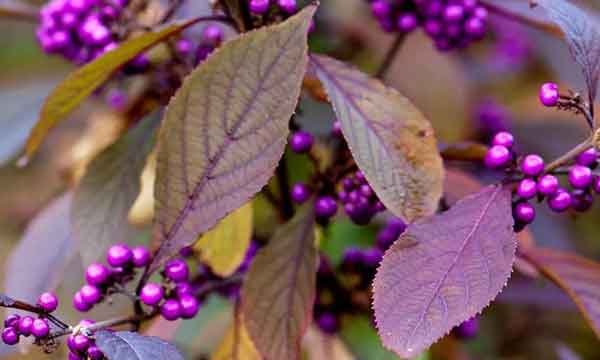
Sanitize pruning tools between each cut by dipping them into a solution of 1 part household bleach and 9 parts water. Although beautyberry bushes generally don't suffer from insect infestations or plant diseases, sanitary tools help prevent spreading the occasional problem.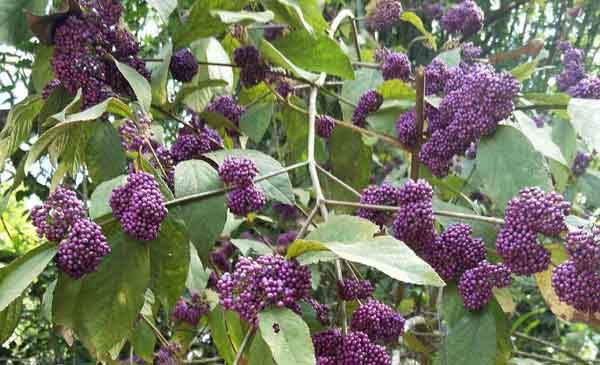
Whether you refer to it as Callicarpa or its more common names of French mulberry or beautyberry, this plant is probably not used often enough in the landscape. It is an ideal choice for a shrub or mixed border or even as a loose hedge. As the featured plant in an autumn container garden, beautyberry is stunning when the fruit display is at its peak. Beautyberry will also tolerate moist sites and can be successfully used in rain gardens. While Beautyberry can be used as a single specimen, you’ll get a better display of fruit if you plant them in groups.
Beautyberry fruits are high in moisture and are an important source of food for many species of birds, including mockingbirds, robins, bobwhite quails, and towhees. Foxes, opossums, raccoons, squirrels, other small rodents, and deer may consume the fruit in the fall after leaf drop. While the berries may last into the winter months, hungry wildlife may strip the berries off in the absence of other suitable food.
'Bodinier's beautyberry' (Callicarpa bodinieri): Bodinier's beautyberry is native to China and grows to around 10 feet tall by 8 feet wide. Like the American beautyberry, Bodinier's beautyberry also produces purple berries. But Bodinier's beautyberry is more cold tolerant than the American version.
'Japanese beautyberry' (Callicarpa japonica): This shrub is native to Japan and reaches around 4 to 6 feet tall and wide. Japanese beautyberry produces clusters of bright purple berries.
'Chinese beautyberry' (Callicarpa dichotoma): This shrub is native to China, Japan, and Korea, and it too produces purple fruits. chinese beautyberry reaches between 2 to 4 feet tall and 3 to 5 feet wide.Beautyberry (Callicarpa americana) Common Pests/Diseases
The only known beautyberry pests are the animals that enjoy the plant's berries. You may see minor leaf spots (Atractilina callicarpae) or black mold (Meliola cookeana), which can be treated with a fungicide.
Beautyberry (Callicarpa americana) PictureBeautyberry (Callicarpa americana) InfoEcological Habits of Beautyberry (Callicarpa americana)Beautyberry (Callicarpa americana) Distribution AreaHow to Grow and Care for Beautyberry (Callicarpa americana)How to Grow Beautyberry (Callicarpa americana)How to Care for Beautyberry (Callicarpa americana)Uses of Beautyberry (Callicarpa americana)Varieties of Beautyberry (Callicarpa americana)Beautyberry (Callicarpa americana) Companion Plants
Beautyberry (Callicarpa americana) Picture

Beautyberry (Callicarpa americana) Info
| Botanical Name | Callicarpa americana |
| Common Name | American beautyberry, beautyberry, French mulberry |
| Plant Type | Perennial shrub |
| Mature Size | 3 to 6 feet tall and wide |
| Sun Exposure | Full sun to partial shade |
| Soil Type | Moist, rich |
| Soil pH | 5 to 7 |
| Bloom Time | Late spring to midsummer |
Ecological Habits of Beautyberry (Callicarpa americana)
The Beautyberry shrub prefers full sun and is intolerant of deep shade. Beautyberry will grow in all types of soil provided there is good drainage. Allow 3 to 6 feet of space for planting unless regular pruning is done. Pruning is best done in late winter. Beautyberry is recommended that old canes be removed for rejuvenation of the shrub because the flowers and fruits appear on new shoots. Beautyberry can be propagated by seeds or stem cuttings.Beautyberry's native habitat is open meadows, thickets, or woodlands. In the spring, green leaves emerge on upright arching stems. Clusters of small flowers bloom on the stems during the late spring and early summer. Clusters of purplish to bluish berries develop August through October and encircle the stem.
Beautyberry (Callicarpa americana) Distribution Area
The native range of Callicarpa americana extends from Maryland to Florida, west to Texas and Arkansas, and also Mexico, Bermuda, the Bahamas and Cuba.
How to Grow and Care for Beautyberry (Callicarpa americana)
How to Grow Beautyberry (Callicarpa americana)
- With Seeds
- With Cuttings

How to Care for Beautyberry (Callicarpa americana)
- Light
- Soil
- Water
- Temperature and Humidity
- Fertilizer
- Pruning
Sanitize pruning tools between each cut by dipping them into a solution of 1 part household bleach and 9 parts water. Although beautyberry bushes generally don't suffer from insect infestations or plant diseases, sanitary tools help prevent spreading the occasional problem.
- Spacing

Uses of Beautyberry (Callicarpa americana)
Landscape UsesWhether you refer to it as Callicarpa or its more common names of French mulberry or beautyberry, this plant is probably not used often enough in the landscape. It is an ideal choice for a shrub or mixed border or even as a loose hedge. As the featured plant in an autumn container garden, beautyberry is stunning when the fruit display is at its peak. Beautyberry will also tolerate moist sites and can be successfully used in rain gardens. While Beautyberry can be used as a single specimen, you’ll get a better display of fruit if you plant them in groups.
Beautyberry fruits are high in moisture and are an important source of food for many species of birds, including mockingbirds, robins, bobwhite quails, and towhees. Foxes, opossums, raccoons, squirrels, other small rodents, and deer may consume the fruit in the fall after leaf drop. While the berries may last into the winter months, hungry wildlife may strip the berries off in the absence of other suitable food.

Varieties of Beautyberry (Callicarpa americana)
Besides the American beautyberry (Callicarpa americana), some other species of beautyberry include:'Bodinier's beautyberry' (Callicarpa bodinieri): Bodinier's beautyberry is native to China and grows to around 10 feet tall by 8 feet wide. Like the American beautyberry, Bodinier's beautyberry also produces purple berries. But Bodinier's beautyberry is more cold tolerant than the American version.
'Japanese beautyberry' (Callicarpa japonica): This shrub is native to Japan and reaches around 4 to 6 feet tall and wide. Japanese beautyberry produces clusters of bright purple berries.
'Chinese beautyberry' (Callicarpa dichotoma): This shrub is native to China, Japan, and Korea, and it too produces purple fruits. chinese beautyberry reaches between 2 to 4 feet tall and 3 to 5 feet wide.Beautyberry (Callicarpa americana) Common Pests/Diseases
The only known beautyberry pests are the animals that enjoy the plant's berries. You may see minor leaf spots (Atractilina callicarpae) or black mold (Meliola cookeana), which can be treated with a fungicide.
Beautyberry (Callicarpa americana) Companion Plants
This Beautyberry plant is best used in mass plantings with companions that include Hydrangea quercifolia, Symphyotrichum oblongifolium 'Raydon's Favorite', Rhododendron maximum, Aronia arbutifolia, Pinus virginiana, and Cornus florida.Read More:
Top 30 Fall Flowers to Plant Beautiful Autumn Flowers
Latest Updated
- Benefits of Bugleweed - 7 Science-backed Health Benefits
- Bugleweed Dangers & Side Effects - Is It Poisonous?
- How to Plant Evergreen Trees - What You Should Know
- When to Plant Evergreens - Grow Guide for Evergreen Trees
- 12 Wonderful Evergreen Shrubs for Your Garden
- 12 Popular Evergreen Plants with Pictures for Beginners
- When And How To Prune A Lilac Bush Like a Pro
- How to Grow & Care for Lilac Vine (Hardenbergia Violacea)
- Japanese Lilac Tree (Syringa Reticulata) Care & Propagation Guide
- Shumard Oak Pros and Cons - What to Know
Popular Articles
- Winter maintenance of Antirrhinum Majus
- How to Grow Terminalia Mantaly Tree
- How to Grow and Care for Crossostephium Chinense
- How to grow Antirrhinum Majus in spring
- Peristeria Elata (Dove Orchid) Profile: Info & Care Guide
- Underwatered Snake Plant (Sansevieria Trifasciata) - Signs And How To Fix
- How to Care for Brazilian Jasmine Plant (Mandevilla Sanderi)
- How to Grow & Care for Graptopetalum Purple Delight in Summer
- Rosa Chinensis (China Rose): Plant Growing & Care Tips
- How to Care for Baby Sun Rose (Aptenia Cordifolia)